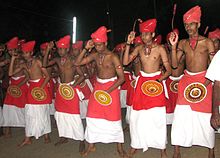Velakali

Velakali is a traditional
Myth behind Velakali
There are several legends associated with the origin and history of Velakali. One such legend talks of the
Performance
During a Velakali performance huge effigies representing the Pandavas are put up during the festival at the eastern entrance of the Padmanabhaswamy temple. In Ambalapuzha, the dance is choreographed under the guidance of Mathur Panickar a hereditary Asan and minister of the Ambalapuzha royal family.
Costumes

Velakali is an all-male performance. The performers dress up in traditional clothes and colorful red headgear of the medieval Nair soldiers and wear cloth garlands of beads that cover their bare chests. They wield colorful shields and long canes or bear swords and dance to the beat of panchavadyam performers who accompany the performance and there are skilful displays of swordplay.[3][5][9]
Music
Velakali is performed to the accompaniment of
Recent trends
Velakali requires of its performers considerable physical training and the knowledge of the use of arms.[10] Education and employment opportunities had gradually led to fewer youngsters taking up Velakali resulting in its gradual decline. It has enjoyed a resurgence in recent years due to the efforts of Mohanankunju Panicker. The dance was staged again at the Sree Padmanabhaswamy Temple in Trivandrum in 2011 after a gap of almost 40 years.[3]
See also
References
- ISBN 9788124108666.
- ^ "Mathoor Panicker". 28 February 2019. Archived from the original on 28 February 2019. Retrieved 13 April 2020.
- ^ a b c d Nagarajan, Saraswathy (27 December 2012). "In step with the times". The Hindu. Retrieved 22 December 2019.
- ISBN 978-81-264-1578-6.
- ^ a b c "Reviving a temple tradition". The Hindu. 15 April 2011. Archived from the original on 19 April 2011. Retrieved 28 December 2012.
- ^ ISBN 9788126419036.
- ^ "Martial artistry". The Hindu. 31 March 2012. Retrieved 28 December 2012.
- ISBN 9780226340470.
- ISBN 9788120806740.
- ISBN 9788126415786.
